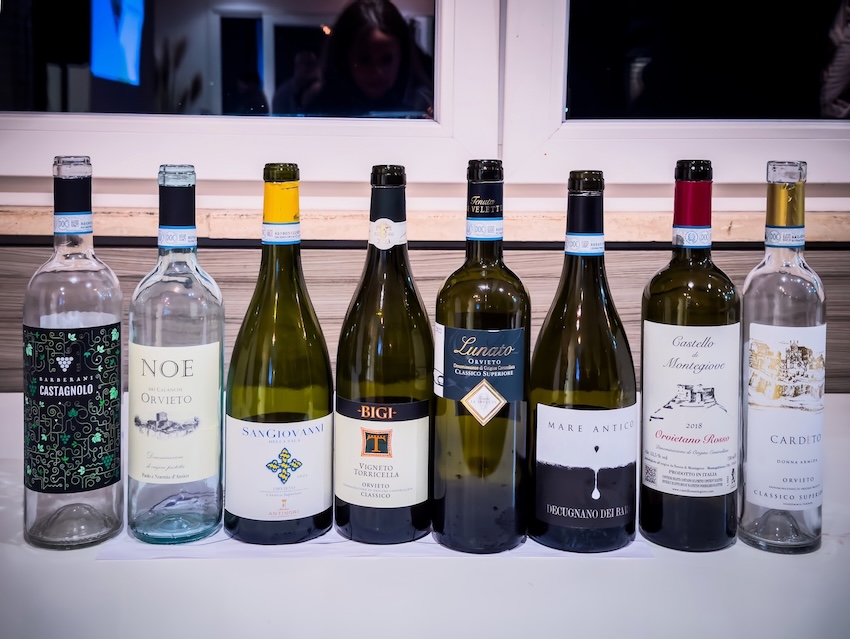AIS Fiumicino – Ostia: Masterclass on Orvieto DOC Wines
Orvieto DOC, one of the denominations of the Italian region of Umbria, was presented by Associazione Italiana Sommelier (AIS) Fiumicino – Ostia on the 13th of May 2024 at Hotel Tiber in Fiumicino. The presenters, both Umbrians, were Gian Luca Grimani, Vice President of AIS Umbria and Maurizio Dante Filippi, Best Italian Sommelier of 2016. Eight Orvieto DOC wines from the Consorzio di Orvieto were tasted. These wines, selected for their representation of the territory, range from white to superior, and red to sweet. The production area of Orvieto Doc extends across two regions: Umbria and Lazio, composed of municipalities in Orvieto and Viterbo in the Teverina area.
Notably, Paolo e Noemia d’Amico’s Noé Orvieto DOP 2023, produced from a blend of grape varieties Grechetto (40%), Trebbiano (30%) and Pinot Grigio (30%) which are cultivated in sedimentary clayey soil and vinified in steel, expressed a profound characteristic of the terroir with underlined aromas of white flowers, hay and crisp yellow stone fruits and notes of almost candied yellow fruits on the mouth.
Tenuta Le Velette’s Lunati Orvieto Classico Superiore DOC 2022 composed of Grechetto (40%), Procanico (20%), Malvasia (20%), Verdello (15%), and Drupeggio (5%) which are cultivated in soil principally of volcanic origin, and vinified in steel with a brief aging on the lees, displayed excellent harmony elegance in its organoleptic characteristics, with a touch of candied berries in the nose on top of its crisp ripe yellow stone fruits and apples.
Decugnano dei Barbi’s Mare Antico Orvieto Classico Superiore DOC 2022, produced from Grechetto, Vermentino, Chardonnay and Procanico cultivated in the oldest vineyards of the estate with roots sinking into the sandy soils rich in seashell fossils, best represents the company. Its vinification is in steel, while 5% of the mass went through malolactic fermentation in barrique, rounding out the wine’s acidity. Pertaining to its name, it is reminiscent of the sapidity of the sea starting from the first aroma to beautiful notes of banana peel and dried orange zest and arriving to the profound and rich personality of the wine.
Orvieto’s History of Wine
Signifying both the name of the ancient city and the wine’s denomination of origin, it reflects the inseparable bond between the place and the wine. This relationship dates back to the ancient period of the Etruscans, who ingeniously crafted winemaking cellars in the tufaceous terrain of Orvieto. These multi-level cellars facilitated a sophisticated process: grapes were pressed on the first level, with the must flowing through earthenware pipes to the second level for fermentation and racking, and finally maturing on the third level. The resulting wine was aromatic, slightly sweet, and golden yellow, epitomizing the region’s affinity for white wines. The discovery of Etruscan artifacts in the city’s necropolis underscore Orvieto’s long-standing viticultural heritage. Over time, Orvieto wine gained prominence, favored by the Roman Empire and the Popes who resided in the city.
The wine’s reputation gained popularity when it was used to fund significant works on the resplendent Orvieto Cathedral. Artists like Pinturicchio and Signorelli, who frescoed the cathedral between the late 1400s and early 1500s, demanded lifetime supplies of the wine. Even Garibaldi and his troops reportedly toasted with Orvieto wine before their Sicilian expedition in the 19th century. It was also during this period when Orvieto wine transitioned from sweet to dry and improving its quality.
Orvieto DOC
Orvieto’s winemaking excellence was formally recognized in 1931 when its production area was delimited, and further cemented in 1971 with the DOC (Controlled Designation of Origin) status which guarantees quality and authenticity. Since 1997, the “Superior” qualification has indicated even higher standards, with stringent production limits and a minimum alcohol content of 12%.
The specifications of Orvieto DOC white wines must be obtained from Procanico and Grechetto grapes (minimum 60%), and other white, non-aromatic grape varieties suitable for cultivation (max. 40%). They come in different types ranging from dry, superior, sweet, to noble rot: The wine is characterized by delicate and fruity aromas with flavors tending towards bitterness in the dry version, sugary, with a candied fruit finish in the sweet version. Due to its structure and elegance, it is a wine that can be drunk as an aperitif or throughout the meal, in particular with fried foods, white meats and fish. The sweet version is excellent with desserts while the noble rot is good with liver pâté, blue cheeses or even as a meditation wine.
The Orvietano Rosso or Rosso Orvietano DOC red wines must be obtained from the main grape varieties of Aleatico, Cabernet Franc, Cabernet Sauvignon, Canaiolo Rosso, Ciliegiolo, Merlot, Montepulciano, Pinot Noir, Sangiovese alone or together for at least 70%. The secondary varieties can be Aleatico, Barbera, Cesanese Comune, Colorino, Dolcetto alone or a maximum of 30%. Its characteristic color is ruby red, sometimes with violet reflections with aromas of red fruit, intense vinous, sometimes herbaceous notes. On the mouth, it’s fruity, soft, elegant, velvety. Orvietano Rosso can be paired with pasta dishes with red meat sauces, roasted meat and mature cheese.
Soil and Climate
The diverse soils and variable Mediterranean climate with significant temperature variations endow Orvieto DOC wines with great complexity and distinct characteristics, depending on vineyard location. The area of the denomination, with ancient origins from the Pleistocene era, is formed by the volcanic complex of the Vulsini Mountains, near Lake Bolsena. The diversity of soil types that can be found throughout the area are classified as: tufaceous with volcanic-clayey origin in the southwest which yield wines with great structure, acidity, and almost sulphurous hints; clayey in the central and northern parts; sandy and rich in marine fossils in the northeast which produce almost marine scents, good structure, and acidity; and alluvial composed of sand and silt along the Paglia river which yield elegant wines











